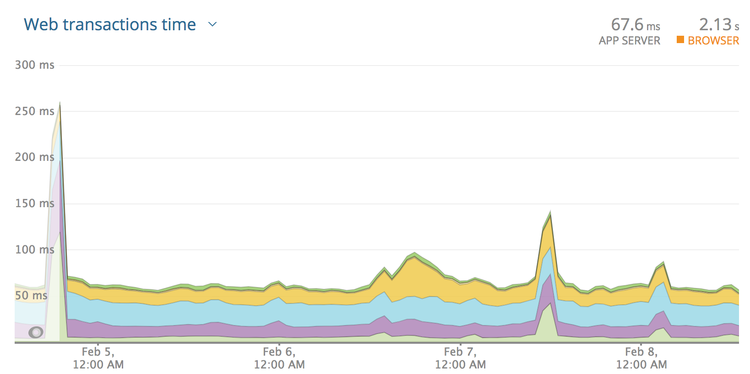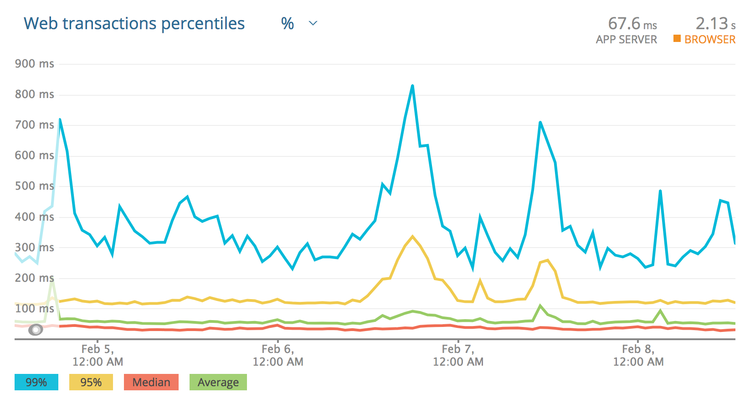Taking a Timeout from Poor Performance

In a system-oriented architecture, it is crucial to communicate with other
systems. In an ideal world each service knows enough information to satisfy its
clients, but often there are unfortunate requirements for data to be fetched on
the fly. Broker patterns, proxies, etc., or even just a remote procedure being
triggered synchronously, like confirming an email has been sent successfully.
All of these things take time. Frontend applications (desktop, web, iOS,
Android, etc.) talk to services, and services talk to other services. This chain
of calls can stack up, as service A calls service B, unaware that system is
calling service C and D… So long as A, B, C and D are functioning normally, the
frontend application can hope to get a response from service A within a
"reasonable time”, but if B, C or D are having a bad time, it can cause a domino
effect that takes out a large chunk of your architecture, and the ripple effects
result in a slow experience for the end users.
Slow applications can cost you a lot of money. A Kissmetrics
survey suggests that every
1s slower a page loads, 7% fewer conversions will occur. This article explains
how you can make your applications remain performant when upstream dependencies
are not, using timeouts and retries.
Other People’s Problems
You own service A, and are making calls to service B. What happens when service
B has a bad day, and instead of responding within the usual ~350ms, it starts to
take 10 seconds? Do you want to wait 10 seconds for that response?

What about if service B is fine, but C is taking 20s and D is taking 25s? Are
you happy to wait 45 seconds for the response from B?
What about two minutes?! 😱

When a server is under load, it can do some pretty wild stuff, and not all
servers know to give up. Even fewer applications know when to give up, and those
that do will take a while to do it.
For example, if service B is on Heroku, we can be confident the request is not
going to last for more than 30 seconds. Heroku’s router has a policy:
applications get 30 seconds to send the first byte, and if that doesn’t happen
then the request gets dropped.
Quite often in monitoring systems like NewRelic or CA APM, you will see things
like this:

This controller has an average response time of 2.9s, but the slow ones are
floating right around that 30s mark. The Heroku Chop saves the caller from being
stuck there indefinitely, but this behavior is not widespread. Other web servers
with different policies will hang forever.
For this reason, never presume any service is going to respond as fast as it
usually does. Even if that team’s developers are super confident. Even if it
autoscales. Even if it’s built in Scala. If you don’t set timeouts, other
people’s problems become your problems.
So, how can we prevent this from happening?
Set Timeouts in the HTTP Client
HTTP clients are usually generic, and out of the box will wait indefinitely
for a response. Luckily any HTTP client worth its salt will allow you to
configure timeouts.
For Ruby users, the HTTP client
Faraday might look like this:
conn = Faraday.new('http://example.com');
conn.get do |req|
req.url '/search'
req.options.timeout = 5 # open/read timeout in seconds
req.options.open_timeout = 2 # connection open timeout in seconds
end
For PHP, Guzzle does this:
$client->request('GET', '/delay/5', ['timeout' => 5]);
There are two types of timeout that a lot of HTTP clients use:
- Open (Connection) Timeout
- Read Timeout
An open timeout asks: how long do you want to wait around to see if this
server is actually accepting requests. That can mean many things but often means
a server is too busy to take a request (there are no available workers
processing the traffic). It also depends in part on expected network latency. If
you are making an HTTP call to another service in the same data center, the
latency is going to be a few milliseconds, but going to another continent takes
time.
The read timeout is how long you want to spend reading data from the server
once the connection is open. It’s common for this to be set higher, as waiting
for a server to generate an answer (run queries, fetch data, serialize it, etc.)
should take longer than opening the connection.
When you see the term "timeout” on its own (not an open timeout or a read
timeout) that usually means the total timeout.
Faraday takes timeout = 5 and
open_timeout = 2 to mean "I demand the server marks the connection as open
within 2 seconds, then regardless of how long that took, it only has 5 seconds
to finish responding.”
Some must die, so that others may live
Any time spent waiting for a request that may never come is time that could be
spent doing something useful. When the HTTP call is coming from a background
worker, that’s a worker blocked from processing other jobs. Depending on how you
have your background workers configured, the same threads might be shared for
multiple jobs. If Job X is stuck for 30s waiting for this server that’s failing,
Job Y and Job Z will not be processed or will be processed incredibly slowly.
That same principle applies when the HTTP call is coming from a web thread.
That’s a web thread that could have been handling other requests! For example,
POST /payment_attempts is making an HTTP call in the thread which is usually
super quick, but unfortunately, some service it talks to is now blocking it for
30s. Other endpoints usually respond in 100ms, and they will continue to respond
so long as there are threads available in the various workers… but if the
performance issues for the dependency continue, every time a user hits POST /payment_attempts, another thread becomes unavailable for that 30s.
Let’s do a bit of math. For each thread that gets stuck, given that thread is
stuck for 30s, and most requests go through in 100ms, that’s 3000 potential
requests not being handled. 3000 requests not being handled because of a
single endpoint. There will continue to be fewer and fewer available workers,
and given enough traffic to that payment endpoint, there might be zero available
workers left to work on any the traffic to any other endpoints.
Setting that timeout to 10s would result in the processing of 2000 more
successful requests.
As a general advice: please do try and avoid making requests from the web
thread, put them in background jobs whenever possible. Sometimes it is
unavoidable, but please go to painstaking efforts to try and avoid doing it.
Making timeouts happen early is much more important than getting a fast failure.
The most important benefit of failing fast is to give other workers the chance
to work.
If the server is a third party company, you might have a service-level agreement
stating: "Our API will always respond in 150ms”. Great, set it to 150ms (and
retry on failure if the thing is important.)
If the service is in-house, then try to get access to NewRelic, CA APM or
whatever monitoring tool is being used. Looking at the response times, you can
get an idea of what should be acceptable. Be careful though, do not look only
at the average.

Looking at this graph may lead you to think 300ms is an appropriate timeout.
Seems fair right? The biggest spike there is 250ms and so round it up a bit and
let’s go for 300ms?
Nope! These are averages, and averages are going to be far far lower than the
slowest transactions. Click the drop-down and find "Web transaction
percentiles.”

That is a more honest representation. Most of the responses are 30–50ms, and the
average is usually sub 100ms. That said, under high load this service starts
to stutter a bit, and these peaks can lead to responses coming in around
850ms! Clicking around to show the slowest traces will show a handful of
requests over the last few weeks coming in at 2s, 3.4s, and another at 5s!
Those are ridiculous, and looking at the error rate we can see that those
requests didn’t even succeed. Whatever happens, setting the timeout low enough
to cut those off is something we want to do, so far I’m thinking about 1s. If
the transactions are failing anyway, there is no point waiting.
Next: if the call is being made from a background worker, that 99 percentile of
850ms may well be acceptable. Background workers are usually in less of a rush,
so go with 1s and off you go. Keep an eye on things and trim that down if your
jobs continue to back up, but that’s probably good enough.
Backup plan: retry
If it’s a web process… well, 2s+ is certainly no good, especially seeing as it
might fail anyway. Waiting around for this unstable transaction to complete is
as much of a good plan as skydiving with just the one chute. Let’s create a
backup plan using retries.
So we have this special web application that absolutely has to have this web
request to Service B in the thread. We know this endpoint generally responds in
35–100ms and on a bad day it can take anywhere from 300–850. We do not want to
wait around for anything over 1s as its unlikely to even respond, but we don’t
want this endpoint to take more than 1s…
Here’s a plan: set the timeout to 400ms, add a retry after 50ms, then if the
first attempt is taking a while boom, it’ll give up and try again!
conn = Faraday.new('http://example.com');
conn.post('/payment_attempts', { ... }) do |req|
conn.options.timeout = 0.4
conn.request :retry, max: 1, interval: 0.05
end
There is potential for trouble here, as the second and first attempts might end
up in a race condition. The interval there will hopefully give the database long
enough to notice the first response was successful, meaning the 2nd request will
fail and say "already paid” or something intelligent, which can be inspected and
potentially treated as a success by the client.
Anyway, (400 * 2) + 50 = 950, with another 50ms for whatever other random gumf
is happening in the application, should mean that we come in at under 1 second!
This is a good place to be in. You have 2x the chance of success, and you’re
setting tight controls to avoid service B messing your own application up.
An important note for Ruby users: you are already using
retries
on idempotent requests, and you probably had no idea. It’s wild that NetHTTP
does this by default.
Next Step: Circuit Breakers
Timeouts are a great way to avoid unexpected hangs from slowing a service down
too much, and retries are a great solution to having another when that
unexpected problem happens. These two concepts are both reactive, and as such
can be improved with the addition of a third proactive concept: circuit
breakers.
Circuit breakers are just a few lines of code, maybe using something like Redis
to maintain counters of failures and their timestamps. With each failure to a
service (or a particular endpoint on that service), the client increments a
failure counter and compares it to a certain threshold. Maybe that threshold is
10 failures in 1 minute, or for higher volume systems maybe 5 failures in a
second.
So in our example, Service A might notice that service B is down after the 10th
error in 1 second, and at that point it opens the circuit breaker, meaning it
completely stops making calls to that system. This will decrease the load on
downstream services (B, C, and D), giving them a chance to recover. This also
avoids the "running out of threads” issue we discussed previously. Even with
service A giving up after 1s, that’s still 1s that thread could have spent
handling other requests.
What to do when a circuit breaker is open? It depends on the feature the circuit
breaker is wrapping.
- Immediately respond with an error, letting the user know the required system is down, and to try again later
- Have a secondary system kick in that handles things in a different way
- Divert traffic to a cluster of servers elsewhere
- Record information about the attempt and have customer services reach out
That’s only a quick intro to circuit breakers, so head over to see Martin
Fowler explain circuit breakers in
depth if you want more
information on the topic.
Envoy is also a great example of a tool that can
handle a lot of this for you at a network level, instead of asking you to code
it up yourself and the application level.
Hopefully, these tips will help keep your applications ticking along smoothly
and avoid a domino effect taking out a giant chunk of your architecture.





